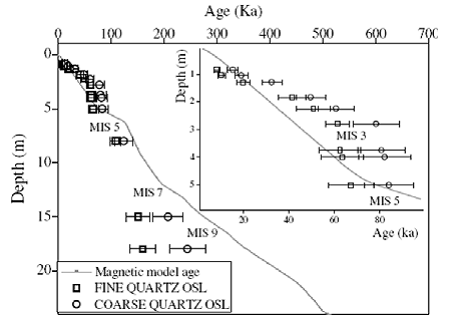LOESSFEST'09 | Aug. 31st – Sept. 3rd, 2009 |Novi Sad-Serbia
Optical Dating of Romanian Loess: A Comparison Between Sand-Sized and Silt-Sized Quartz
Timar, A.1,2, Vandenberghe, D.A.G.2, Vasiliniuc, S.1, Cosma, C.1
1Faculty of Environmental Science, Babes-Bolyai University, Cluj Napoca, Romania.
2Laboratory of Mineralogy and Petrology (Luminescence Research Group), Department of Geology and Soil Science, Ghent University, Belgium.
The Romanian loess-palaeosol sequences preserve a significant terrestrial record of Quaternary climate change during at least five Glacial / Interglacial cycles. In comparison to similar sequences elsewhere in Central and Eastern Europe, the deposits in Romania have been less extensively studied. Recent studies of the magnetic properties of the loess / palaeosol sequences have demonstrated the potential of magnetic susceptibility as a climatic proxy. However, this approach assumes that the deposits are complete and it can only provide indirect age information for entire units. Absolute dates are essential to confirm the stratigraphic position of the palaeosols and to determine the precise rate of processes as sedimentation and pedogenesis.
We have recently reported the first optically stimulated luminescence (OSL or optical) ages for the loess-sequence near Mircea Voda (Dobrogea, SE Romania); that study focused on loess from the last three glacial periods and used silt-sized (4-11μm) quartz as dosimeter (Timar et al., 2009). An internally consistent set of optical ages was obtained for the loess deposited up to ~70 ka, and evidence was presented for a varying loess accumulation rate during the Last Glacial. While it could be confirmed that the uppermost palaeosol (usually denoted by “S1” in stratigraphic nomenclature) formed during the last interglacial, comparison with independent age control (pedostratigraphy and a newly-developed palaeomagnetic time-depth model) also indicated that the dating procedure underestimates the true burial age from the penultimate glacial period onwards.
This work reports on our further investigations into the cause of this age underestimation. In addition to a more detailed study of the luminescence characteristics of the silt-sized quartz, we investigate the luminescence properties and age of the fine-sandy (63-90) quartz fraction.
Our study used the same samples as Timar et al. (2009), from which quartz grains were isolated of both the 4-11μm and the 63-90μm fraction. The purity of the quartz extracts was confirmed by the absence of a significant infrared stimulated luminescence (IRSL) response at 60°C to a large regenerative _-dose and by the presence of well defined 110°C TL peaks. All samples behaved well in the single- aliquot regenerative-dose (SAR) protocol; recycling ratios are close to one and growth curves pass very close to the origin. The suitability of the measurement protocol was further evaluated through a dose recovery test; the given dose was chosen to be equal to the estimated equivalent dose (De) and ranged from ~28Gy to ~ 480Gy. For the fine and the coarse grained-quartz, the overall (n=12) average measured to given dose ratio is 1.04±0.04 and 1.04±0.02, respectively. As both the De as the ratio of the measured to given dose were found to be independent of preheat temperature, De’s were determined using a SAR protocol with a preheat of 10s at 220°C and a cutheat to 180°C; at least 11 replicate measurements were made per sample and grain size fraction.

Fig 1: Plot of optical ages (open squares-fine quartz, open circles-
coarse quartz; 1 sigma total ncertainties) as a function
of depth; the results from the palaeomagnetic time-depth
modeling are shown by the gray line. The inset shows the
optical ages obtained for the L1 unit.
Fig. 1 compares the optical ages obtained on the finesandy quartz fraction with the previously obtained age results (silt-sized quartz and the magnetic time-depth model; Timar et al. 2009). The ages obtained on the 63- 90μm fraction are consistent with the stratigraphic position of the samples, but they are consistently significantly older than the ages obtained on the silt-sized quartz. Both sets of optical ages indicate that the L1 unit did not accumulate at a constant rate. Samples taken from below the S1, S2 and S3 palaeosols yield optical ages of ~110ka, ~150ka and ~160ka for fine grains; the corresponding optical ages obtained using the coarse grains are ~130ka, ~180ka and ~230ka.
The optical ages obtained on coarse grains are in between ~20 to ~70 % higher than those obtained on the silt-sized fraction, with the difference being more pronounced in the case of the younger samples. We consider incomplete resetting of the OSL signal in the coarse quartz grains unlikely: the grains have a windblown origin, De(t) plots are flat and the distribution of dose measured using small aliquots is symmetric. The De in the fine quartz grains is independent of both preheat temperature and the OSL signal integration regions; this suggests that significant contamination of the dosimetric signal by a thermally unstable component is unlikely. As the coarse and fine quartz grains behave in a similar manner in the SAR protocol, both in terms of sensitivity change and performance (i.e. recuperation, recycling ratio and dose recovery), their apparently different age is unexpected.
Investigations that aim at resolving this discrepancy are ongoing; these involve LM-OSL experiments and thermally stability tests (to provide direct evidence for the dosimetric signal in both grain size fractions to be dominated by the fast component), as well as a thorough examination of the growth curve characteristics. The results of these experiments will be presented at the meeting.
References:
Timar, A., Vandenberghe D., Panaiotu E.C., Panaiotu C.G., Necula C., Cosma C., Van den haute P. Optical dating of Romanian loess using fine-grained quartz. Quaternary Geochronology, 2009 (doi: 10.1016/j.quageo.2009.03.003).



